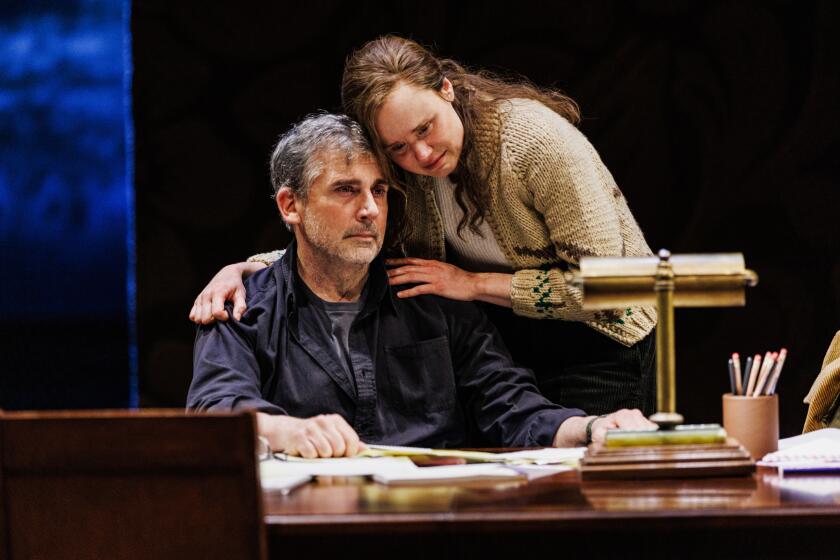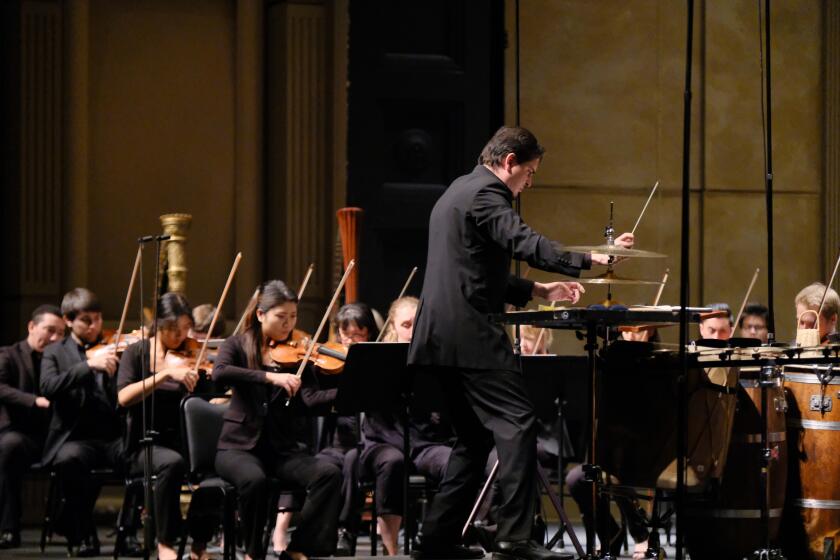Historian’s eye on the storm
It’s one thing to write about history as Douglas Brinkley has done for more than two decades, often to much fanfare and acclaim. It’s quite another to be swept up with your young family by its fast-moving and unpredictable currents.
With Hurricane Katrina bearing down on the Gulf Coast, the 44-year-old Tulane University professor decided to stay in New Orleans not to bear witness to a national tragedy -- although that’s precisely what happened -- but simply to avoid getting stuck in bumper-to-bumper evacuation traffic.
Along with his wife and their two children, then both younger than 2, Brinkley’s plan was to “evacuate vertically” into a riverfront high-rise -- designed by his father-in-law -- that was built to withstand a Category 5 hurricane. And there from the 15th floor, the telegenic historian, a popular guest on cable news programs, watched as his adopted home became the news story of the year.
Huddled as he was with his wife and children in a rented room with pieces of the high-rise’s roof beginning to fly off, Brinkley could have scarcely known at the time that the catastrophe would cast him and the nation into a series of surreal, terrifying and even enraging events that history may some day judge as pivotal in resetting the country’s social and political agendas.
As Katrina hit landfall in New Orleans, Brinkley saw the mighty waters of the Mississippi River run backward as they retreated before the immense power of the onrushing storm surge from the Gulf of Mexico. He saw the windows of the downtown Hyatt Regency pop out like holes in computer punch cards. In the coming days he observed police officers tremble with fear, trucks loaded with supplies for storm victims be turned back by federal officials, and something he thought he’d never see in a major metropolitan area -- completely dark and deserted freeways.
“It was like a B-grade post-apocalyptic movie,” said Brinkley at a restaurant in Houston, where Tulane University as well as his family have since relocated. “I was zooming with my family, the wife, the kids, the dogs down an empty freeway, and there was so much destruction all around.”
And here is where his personal tale gets stranger, Brinkley explained. He is, well, friends with actor and sometime activist Sean Penn, and the unlikely pair soon found themselves on a CNN boat with a clergyman from Noah’s Ark Missionary Baptist Church rescuing flood victims from the roofs and treetops of New Orleans.
The stranded “would be panicking and suddenly the lightbulb would go on,” recalled Brinkley, a prolific author of popular works on such diverse subjects as John Kerry, Rosa Parks and Henry Ford. “They were like, ‘Get me out of here, get me out of here.... [Hey, are you] Sean Penn?’ I think it actually reassured them.”
It all sounds like a movie, but actually it’s going to be a book.
Analysis and oral histories
It’s called “The Great Deluge” and Brinkley expects it to hit the bookstands around Aug. 29, 2006, the one-year anniversary of Katrina’s hitting New Orleans. Published by William Morrow, the book will be filled with hundreds of oral histories as well as a critical analysis of the local, state and federal response to the crisis.
“There’s going to be a cottage industry of books about Katrina almost like a Gettysburg or an Antietam,” said Brinkley, who put aside a project on Theodore Roosevelt and conservation to focus exclusively on the upcoming book. “It will be reinterpreted in books for decades, even centuries.
“There’s no way it’s going to be definitive,” added Brinkley about his upcoming book. “But hopefully it might be an opening salvo in the scholarship.”
Brinkley makes clear he won’t be, as he said, using the “I” word. As such, the book will be leaving a great many personal screen-worthy moments on the cutting room floor, so to speak. For instance, the bizarre televised CNN interview in a flooded New Orleans street, featuring Soledad O’Brien with Brinkley and Penn both calling for more aid to the stricken city.
In a pairing odd enough to be a premise for a Hollywood cop buddy picture, the award-winning historian and the Oscar-winning actor became friends recently after Penn rented a home in Brinkley’s New Orleans neighborhood while shooting a remake of Robert Penn Warren’s “All the King’s Men.” The two had a mutual friend in Hunter S. Thompson, and Brinkley is knowledgeable about Huey Long, the former Louisiana governor on whom the character Penn portrays in the upcoming film is based.
“Sean has always liked New Orleans,” said Brinkley, who notes that the actor has “NOLA” tattooed on his arm. “He likes those Charles Bukowski, Tenderloin, misfit, outcast characters that the city has so many of.”
After driving his family out of New Orleans before the levees broke, Brinkley heard from Penn. The Marin County resident was so moved by the televised scenes of suffering, he wanted to go to New Orleans -- and by the way did Brinkley want to come along?
Within days, the pair were able to sneak back into the flooded and besieged city with the help of a government official Penn had befriended during the filming of “Dead Man Walking,” some of which was shot in Louisiana. Once on the ground, or what was left of it, in New Orleans, the two persuaded a CNN newsman to head out into the city to help stranded people. After picking up the reverend from a nearby church, that’s exactly what they did.
“We put this boat into the filthy, slimy waters. People were waving flags everywhere, just begging to get out,” Brinkley said. “It was like something out of ‘Apocalypse Now.’ ”
But Brinkley quickly discovered they weren’t alone.
“That’s the big story that has not been written because the media at that time were so focused on the evacuation,” Brinkley said. “What was occurring was the formation of a citizen navy. There was a large group of people -- Cajun boat people, fishermen, boat fanatics, this is the sportsman’s paradise after all -- and they were out there doing the primary rescue work in urban downtown New Orleans. Bar owners, ministers, stockbrokers, hardware store owners were out there, part of a huge flotilla of boats.”
Taking on the calamity
As Brinkley glimpsed firsthand, the ordeal was just beginning for those residents who couldn’t or wouldn’t leave. Ill-prepared for the disaster, the city warehoused few supplies, and much of what was headed into the city never reached the hurricane victims, Brinkley said.
“I witnessed big private-sector trucks trying to bring in water being threatened by FEMA,” he said. “Their worry was that these trucks had explosives on them. They were in a post-9/11 mode where security issues prevail over humanitarian ones. They were these bureaucrats who didn’t want to be the one responsible for letting in the truck that turned out to have a bomb on it.”
It was these types of experiences that compelled Brinkley to take on the calamity in his upcoming book. As a historian, he realized the danger of being so close to a subject, but he also couldn’t resist the advantages in this case. Committed to using oral histories from everyone from city leaders to ordinary citizens, Brinkley wants to infuse the book with the precision of detail only possible soon after an event. He spent four days tape-recording victims’ stories at the Astrodome.
“I oversaw thousands of D-day oral histories and I learned the difference between doing a journalistic interview when things are fresh in people’s mind and when you have to wait a bunch of years,” said Brinkley, who will donate the book’s proceeds toward a New Orleans museum chronicling the tragedy. “Great oral histories are about detail, when the clock is still in their minds. What I’m getting is a lot more than ‘I evacuated my house, went to the Superdome and took a bus to Houston.’ ”
His book will carry more than just personal accounts. It will also be intensely critical of the government response -- at all levels. As someone who voted for Mayor C. Ray Nagin, Brinkley was particularly outraged by the local response. The city had a hurricane plan -- evacuate residents to the Superdome -- but no flood plan, which was the real danger. Brinkley found Nagin’s exaggerated estimate of the death toll -- 10,000, when the true number turned out to be about 1,000 -- almost unforgivable. At the time, Brinkley was visiting victim shelters in the state capital of Baton Rouge, where chaos reigned as separated families were desperate to find their loved ones.
“When he gave that figure, it just devastated people,” Brinkley said. “If you couldn’t find your mom and someone says there are 100 deaths, you are hopeful, but someone says 10,000 and you think, ‘My God, they are going to be one of those statistics.’ ... I can’t imagine a time in American history when a mayor behaved so abysmally from every point of view.”
President Bush will hardly fare better in Brinkley’s book. Even ignoring the well-documented “lameness” of FEMA, as Brinkley puts it, he says the president is failing to properly lead the recovery effort. Brinkley argues Bush should demand a federal inquiry similar to the Sept. 11 commission.
“Bush needs to step up and say this region is a disaster and we’re going to treat it like a Marshall Plan, the way we rebuilt Europe after World War II,” Brinkley said. “He also should urge a congressional investigation of what went wrong and why. I tell you Theodore Roosevelt would do it. So would Ronald Reagan. And by not doing it, you’ve got the incredible shrinking presidency of Bush and the real chance if we don’t get it right, it could happen again.”
More to Read
Sign up for our Book Club newsletter
Get the latest news, events and more from the Los Angeles Times Book Club, and help us get L.A. reading and talking.
You may occasionally receive promotional content from the Los Angeles Times.






